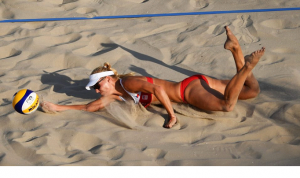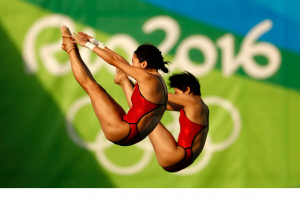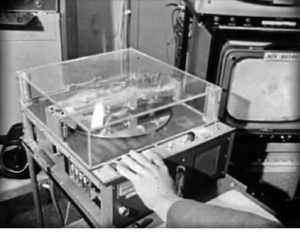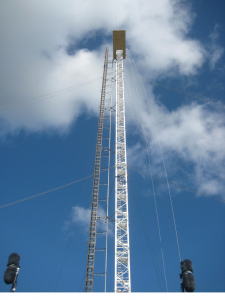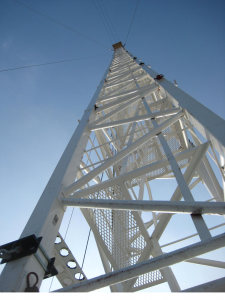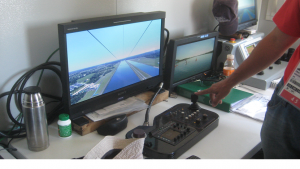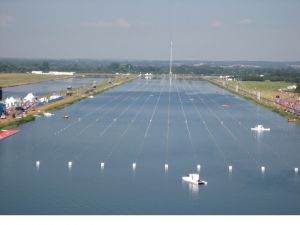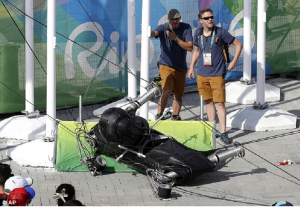Opening Ceremony
Dave Mundy
What a fantastic VISUAL feast but what a serious let-down sound-wise! Surely, someone should have taken control of the sound output – it was so obviously taken from the arena acoustic PA and was not thought about, we deserve better than this! Just a single connection to the arena PA desk would have transformed the whole experience for the viewers back home! Come on back, BBC OBs!
Martin Eccles
The BBC Olympic HD Channel (Freeview HD 114) carried a "commentary free" feed that was a much tighter stadium sound but unfortunately was not in surround sound as was the main BBC 1 HD programme.
This probably will be the same for the Closing Ceremony as well.
At least this year Sports did the commentary, not News.
Dave Denness
I know from Audio friends of mine in Rio that the Opening ceremony was done for OBS on a LAWO mc²66 MKII console in Dolby 9.1 surround. The track and field (athletics to BBC people) will be on a Calrec console.
The Sound Supervisor was Jayson Polansky, who I have worked with at Wimbledon for several years, a very talented sound man who any of my BBC colleagues would be very happy to work with. He has never heard of Kendal Avenue.
I have no idea what source the BBC took to feed on to the UK.
Having now seen a replay of part of the opening ceremony I would guess someone ordered the wrong feed from OBS, the host broadcaster. Not unknown with modern production staff, both inside and outside the BBC.
The BBC sound mixer, wherever he/she was from can only use the tools provided.
Bernie Newnham
LAWO mc²66 MKII : specially designed for top sound mixing and easy pronunciation!
Nick Ware
They haven’t found a way to fold 5.1 down to stereo satisfactorily yet for the 90% of us who don’t have or want surround at home. What chance 9.1?
Dave Plowman
Very true. The vast majority don’t even have decent stereo – so do wonder how many would watch any TV prog in surround (feature films being a different matter).
But surely on this sort of prog you’d do your monitoring using the most common domestic format by far – stereo? Or rather two channel with the speakers close together.
Terry Meadowcroft
I tried every which way to make sense of the sound on the Opening Ceremony. I was watching on BBC1 HD. No matter what format I tried, there was clearly no feed coming to me from the lead singer’s mic. I eventually gave up. Awful.
A great deal more care in the negotiation process is clearly required in future to ensure the excellence of the sound we are about to send to our millions of viewers, with a carefully organised ‘fallback’ mix in case of disaster occurring on plan 1. BBC’s face should be very red, but I’ll bet it isn’t!
The coverage of the long distance cycle race was OK.
The sound from the Newsroom for the news was thin and spiky. Made a change from the newsroom’s usual woolly and topless.
Mike Giles
Not wishing to be parochial, (well I am really) but during the time that I was involved with Olympics, CWG, World Cup, etc., it was the TVC overseas team who handled the ceremony commentary and FX mixes and we relied heavily on having a direct feed of the PA. I hope that we always made it exciting!
The most exciting one for the BBC control room was Auckland CWG, when at his insistence we arranged a reverse cue function for David Coleman, so that he could let us know when he intended to speak. Because of the relatively complex arrangements for DC’s feedback, his cue tone went round the loop and achieved an ethereal quality (not transmitted, I hasten to add). This caused great amusement when he first used it, aided and abetted by the fact that David had used his lazy to Martin Hopkins to warn us that he was about to use his reverse cue! He then waited so long after pressing the button that it made no difference at all, because we always relied on listening for his first syllable, or even an intake of breath, to drop the FX by a dB or two anyway, if indeed that was necessary. It merely required paying close attention and I don’t think the reverse cue was ever resurrected. The thing we strived for most diligently was that intelligible speech from PA never conflicted with BBC commentary and the likes of Martin Hopkins and Jim Reside were always reminding commentators to allow the PA to feature and speak in the gaps where possible. That practice is sadly lacking at most events nowadays ~ even Wimbledon (distinctly OBs) quite often has two intelligible voices at once nowadays, which never used to be the case.
Auckland’s closing ceremony was the famous occasion when DC proclaimed on air with great authority that “there are no fireworks in this closing ceremony” BANG! absolutely on cue ~ and quite good fireworks they were too.
And on Martin’s point, although I didn’t hear (or watch) the Rio opening ceremony as it was past my bedtime and I’ve missed the repeats, I am dancing with joy that a certain individual was absent! I never understood how it came about. (Another retraction ~ I think I probably know why.)
Does anybody know where sound and vision is being mixed this time? For the last two events or so, virtually all the mixing has been in Salford, which could well explain why a direct PA feed was not available, although I’m sure it could have been arranged. I recall that for the Russian OWG, it was obvious that there was delay in both directions, but with fibres all over the place nowadays, delay is not really an issue. We visited the Telecomms Museum at Porthcurno last week and I was staggered at how extensive the cable network used to be from early doors, and how extensive the fibre network is now. Well worth a visit if you haven’t been, with the Minack Theatre just up the hill ~ reduction for visits to both!
Dave Mundy
Did you know that Brendan Shore and Bob Leacroft installed the audio system at the Minack Theatre in the 1970s? (they both worked in TVC).
Mike Giles
Very interesting. I knew both well, particularly Brendan, of course, as a fellow SS.
Unfortunately we missed out on a show at Minack as it was totally sold out for the whole of our time in Cornwall, but a good reason to go again – absolutely fabulous setting and what an inspired lady to envisage such a project.
Beach Volleyball
Dave Mundy
The well-known magazine ‘Voyeur Weekly’ rates beach volleyball as the top Olympic sport. Having accidentally watched some this afternoon I can’t understand why! I personally think the so-called sport should be covered on radio and not on TV HD. This would save the NHS a fortune in call-outs for premature heart failure among elderly men.
(Click on the picture below to see larger version:
use your Browser’s BACK button to return to this page)
Alasdair Lawrance
What exactly do you mean by "accidentally"?
Dave Mundy
‘Accidentally’ means I didn’t deliberately choose BBC1 when I switched the TV on, it decided that for itself, honest!
Peter Cook
The channel info probably said Tennis or Hockey. I know that the info on RB has been comprehensively misleading and so has the Radio Times schedule. Yesterday the Judo channel said Fencing and vice versa, likewise Tennis proved to be Men’s Volleyball. Obviously a computer somewhere does not know what sport it is watching, or a person is asleep.
Robert Miles
Wrists have been slapped here in Salford with the Red button team.
Peter Cook
For high blood pressure, close behind volley ball is synchro diving, behind being the operative word!
(Click on the picture below to see larger version:
use your Browser’s BACK button to return to this page)
Pat Heigham
I caught a bit of the synchro diving! The thighs on some of those gals! (reminds me of the line from Peter O’Toole in "What’s New Pussycat" where he and Sellers are watching a strip show – which we don’t see, he says; " I like thighs!" somewhat lasciviously) (or was that Sellers’ line?)
Mike Minchin, Dave Denness
The stripper that Peter O’Toole and Peter Sellers were ogling was Paula Prentiss (now 78 (2016)), and, while nothing got onto the final film, the act was filmed. I have seen a rather decorous still.
Alasdair Lawrance
’Synchro diving’ – always known in our house as ‘Formation Drowning’!
Mike Jordan
I note that red button feeds all appear on Freesat in the “non freesat” view spread across loads of transponders together with HD and SD feeds.
At least (due to regional opt-out provisions?) real programmes like News and “EastEnders” are staying on BBC 1.
It looks like RB8 not available until late so kiddies can keep their Cbeebies whatever as have run out of transponder space.
I assume that somewhere all the 525NTSC feeds from South America are converted to 30 line or 405 line or whatever we use and at the proper frame rate of 25c/s not 30c/s (he he).
Good job they installed lots more coax tubes across the Atlantic wasn’t it to carry all these circuits.
Pat Heigham
I find it somewhat sad that the only people who care about Quality Control of today’s BBC output are us old retired Tech-Ops farts.
Perhaps it’s because we do care, as we knew what was what in the days past, and took pride in the programme generation.
No doubt management thinks it knows better, but in dispensing with the beautifully designed and systemic TVC, where everything was centralised and efficient, then farming out OBs and network
distribution, and doing away with expert training of staff, not only have they thrown the baby out with the bathwater, but lost the soap and rubber duck as well!
Alasdair Lawrance
Apart from the ‘old farts’, I also find it very disappointing that the general public don’t seem to either notice or care. This morning there was an interview of some horsey thing from Stoneleigh full of the operator’s shadow, even on the static shot. It was OK when s/he had to tilt up for a shot of the rider, but not when a shot of the interviewer was required.
And, of course, it was hosing around all over the place – pass the Kwells!
John Howell
That reminds me of a report from Wyre Davies a few days ago. He was in MCU in the foreground of a shot looking down over Rio. You could hardly make out his face he appeared as a silhouette. At the very least a sheet of white card or a hotel towel could have bounced a little light in. But then what would a mere sound man know about such things.
Peter Cook
In the old days we could ring up the duty officer and complain about things that were obviously wrong, but I have no idea now how to talk to the duty computer! Perhaps together we can find a real person to annoy who might have some influence?
If back then we had been lucky enough to have access to some of the modern toys and technology our high professional standards could have been supreme more often. As for wobbly shots, everyone now has a video camera in their back pocket, so they are all ‘experts’, a bit like the young boys with their back to front baseball caps who have cars ‘know how to drive’ (to the scene of the next accident or others off the road)
A couple of years ago a BBC stringer came to our village shoot an interview with my wife who as clerk to the parish council at the time was delegated spokesman on a planning issue. The young lad invited me to operate the camera. The first switch I found was manual iris! I had to quickly find the iris ring as the sun was in and out like a yoyo, but at least I kept the subject exposed. And he was BBC ‘trained’.
Pat Heigham
Some years ago, I was called for a job to film an insert with Malcolm Gluck, the ‘Sunday Times’ Wine guru – he had to judge 50 whites and 50 reds which could be bought on the High Street for under a fiver (Yes, it was a few years ago!)
But I digress – it was a schplendid schoot, by the (hic) way!
It was in the boardroom in the ‘White’ building beyond TVC, and at lunchtime I went for a wander down the corridor – reading the ‘jobs available’ on the notice boards, I was incensed at an advert for researchers to be ‘trained’ in camera operation of handycams!
After all our expensive proper training and experience…
I saw a programme where this had been put into practice. The main cam was doing the interview subject, but some other supernumerary was wielding said handycam, taking alternative angles – sad to say they got the wrong side of the eyeline between interviewer and subject and completely crossed the line. Bah!
That also happened with a so-called professional cameraman of my acquaintance – not that well trained, but on a job for a small production company I used to work for, managed to cross the eyeline for the interviewer’s reverses. Tried to flip the image in edit – didn’t work!
Hugh Sheppard
Not only Tech Ops farts break wind about today’s ‘Quality Control’; TV Presentation and Network Engineering taught very many of us from far and wide what QC really ought to be about. True, folk such as Bernie and me came from Tech Ops, but unlike our alma mater, Pres was 50/50 boys and girls, so none of the latter’s standards originated there.
Those were the days, my friends…
Graham Maunder
(Working for NBC at Rio)
What is really depressing is when, like last night in Rio, I have to put up with having the piss taken out of me by some (very good) photographers over some of the BBC pieces to camera at rowing with John Inverdale and Sir Steve Redgrave with not a light or reflector used. It was shocking.
The Caipirinha’s were good though so not a total write off!!
Graham Maunder, John Nottage
Caipirinha: Isn’t that a man-eating fish?
No. It’s a man-eating cocktail – if you have too many. Delicious.
Roger Long
When we were filming in up country Surinam we would catch piranhas with machette blows to the head, after baiting the river with chicken bones. Easy-ish after a few goes, we then smoked them over the fire.
One day our Government rest house was visited by a UN World Health working party, checking for new Malaria species. They had a crate of Gordons Gin. We had a great party, in the morning the river was full of empty gin bottles, bobbing with the piranhas
Rowing
Pat Heigham
I caught some of the rowing sculls event. Very impressed with the cable slung travelling camera. Think the course was 2000m, so a terrific rig.
I wonder if a Swiss cable car installer was brought in? (I think the current cars of the Sugarloaf mountain cableway are Swiss-built – Bond and Jaws had a fight on it for “Moonraker”.)
Dave Mundy
Makes Lime Grove seem rather tame!
Martin Eccles
The rowing races are all over the 2000 metres long course at the Rodrigo de Freitas Lagoon.
The aerial Camcat cables are slung the centre length of the course between two HUGE pylons on the shore, so the cables are well over 2 km long. The finish pylon is occasionally visible in shots where the crews are shown after the race getting out of the water.
Coverage from the shore is provided by eight handheld cameras and 12 hard-wired camera, including a super-slow-motion system near the finish line. Aerial coverage is provided by a drone flying alongside the course over the lagoon (and far from spectators) as well as the Camcat cable system.
The production is also making use of seven cameras mounted on five boats on the course. Two of the cameras are high-speed super-slow-motion systems; a third is a regular super-slow-motion. What makes the production unique is that there is an EVS system and operator on each boat that has the high-speed camera and clips are created on the boat and sent to the production team on shore via wireless transmission. Because only the clip is sent, the production team doesn’t have to transfer massive amounts of camera data from the boats.
Pat Heigham, Alasdair Lawrance
Many thanks for that breakdown! What a tremendous rig!
27 cameras by my reckoning, for the rowing alone!
I was mightily impressed by the slo-mo of the kayaking. Many of us no doubt remember the Ampex disc system all those years ago – VR 1000 ?
The other thing that impresses is the overlay ‘caption’ which ‘sticks’ to the frame and moves with the image.
Bernie Newnham
From Mr Booth’s site:
http://www.vtoldboys.com/images/sport007b.jpg
(Click on the picture below to see larger version:
use your Browser’s BACK button to return to this page)
"You want a few minutes on the video disc? Not a chance, Sport have got it booked to the 21st century."
Graeme Wall
I saw it used it, unsuccessfully, on a Noel Coward drama about 1975. One actor had to slap the face of the actress playing his wife and they tried to do it gently and speed it up on the videodisc. Looked totally unconvincing so at the end of the scene, at her suggestion, we shot the slap as a cutaway.
Make-Up spent most of the ensuing lunch break disguising the red mark!
Chris Booth
I used it on "Life at Stake – Apollo 13" (1978) for the ‘weightless’ shots inside the capsule. For the technology of those days it worked pretty well.
Graham Maunder
‘Live from Rio’!
The cable system was actually put in by an Austrian company so definitely relying on skiing expertise!
It’s a staggering 2.5 km stretch.
We’ve got lots of toys here at the Olympic Stadium but none quite as impressive as that.
However, I do at least light our presenters – and very soon we will have the enigmatic Usain Bolt to thrill us for 9 and a bit seconds!!
And the sun’s out!
David Beer
The Camcat rig sounds exactly the same as the one that was used for the rowing at Eton Dorney for the London 2012 games. It was installed by an Austrian company, and the massive gantries went in a good 6 weeks before the event. I was on a camera underneath the gantry at the start end of the course for the rowing and about a quarter of the way up the gantry (it still felt fairly high!), at the finish end for the canoe and kayak sprint events. We had around 26 cameras covering the event and I have a few photos I took at the time.
Gantry at start end:
(Click on the pictures below to see larger versions:
use your Browser’s BACK button to return to this page)
Camcat control room:
View from camera position part way up finish end gantry:
The Camcat guys said the main control cable was a non stretch Kevlar rope which at the time was the longest that had ever been made, and they had a spare in case it broke!
Graham Maunder
I’m sad to report that the cable-cam in the Olympic Park has just come down.
I was on my hotel roof opposite when it happened so can’t see/tell if any injuries – I hope not.
Mike Jordan
Apparently injured 7. The camera had been suspect previously due to damaged cable, but used anyway!
[Daily Mail]
“… Five of those injured were hurt by the cable – with two hit by the 600kg camera… According to reports, Olympic security officials had been alerted earlier in the day that a steel cable holding the equipment had broken and the area had been partially isolated…”
… However according to a Globo News Team, OBS representatives had dismissed the risk of the camera falling even after one of the cables had snapped…“
(Click on the picture below to see larger version:
use your Browser’s BACK button to return to this page)
Graeme Wall, Tony Crake
Does it really weigh 600kg? Surely 600kg is about half an old ton ! 1320lbs
Steve Edwards
600kg? – You would have thought even 60kg would be quite a heavy weight to have flying around on a cable above people’s heads. 60kg is nearly two and a half bags of cement in my language!)
…or is the 600 kg including the cable framework?
Mountain Biking
Colin Hazelwood
I’m doing the mountain biking and today we had a bushfire combined with high winds had to evacuate site. Now back at accommodation we watched the flames up to 100 feet high and looks like we’ve lost quite a few cameras. Crew safe, nobody hurt.
Dave Mundy
I must say that the mountain bike course looked a bit scorched: after Colin’s note, I’m not surprised! I wonder how much gear was lost! I hope that it was insured!
Colin Hazelwood
Actually we got away with things quite lightly.
Although the mountain bike course was downwind of the original bush-fire, it was on the leeward side of a hill. Coupled with the fact that the track itself acted as a firebreak, we were amazed to see what little damage had actually taken place to the equipment.
Mostly it was cables and fibre-optics lying on the ground that got a bit scorched and needed replacing along with one of the tracking cameras owned by Aerial Camera Systems (ACS) which required major surgery on the quite sophisticated and costly motorised track.
Amazingly the even more sophisticated and costly Cineflex camera mounted on the track at the time survived despite being somewhat singed.
Then four hours after the fire started, there was a sustained downpour of rain in typically Brazilian proportions, which doused everything and certainly extinguished any glowing embers that may have remained.
Maybe "Christ the Redeemer" really was looking down upon us after all.
Overall it’s been an enjoyable, eventful and sometimes exciting Olympics – but I won’t be sorry to get home.
Commentators
Dave Mundy
As I surf the red buttons I am surprised by the number of commentators that I do not recognise! Many of them appear to Australian or New Zealanders. Does anyone know if the Beeb are taking a pool feed or have we run out of bodies?
Rob Miles
The Red Button and Web streams have a mix of OBS host and BBC commentary teams.
All commentary circuits on site are managed by OBS commentary control with all circuits going back to the IBC for distribution to the broadcasters. The BBC at the Rio IBC can switch between Host, On site BBC and local Off Tube commentary. This switched commentary is embedded with the stereo clean fx with the world OBS pictures from the event.
Each event can then be assigned to one of 24 fibre circuits to Salford which then get assigned to Red Button and Web streams.
-
OBS – Olympic Broadcast Services
IBC – International Broadcast Centre
Dave Mundy
How do they cover the yachting with that enormous wide angle and graphics for each boat?


